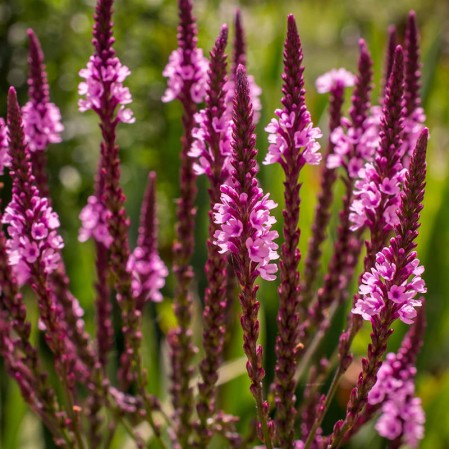Pink Vervain Seeds
Verbena hastata rosea
- HOW TO GROW
- FAST FACTS
HOW TO GROW
Sowing: Direct sow in late fall, pressing the seed into the surface of the soil. For spring planting, mix the seeds with moist sand and store in the refrigerator for 30 days before planting. Keep the soil lightly moist until germination.
Growing: Water seedlings until they become established. Since they prefer moist but well draining soil, mature plants have limited tolerance for drought. These plants adapt well to many soil types. This plant attracts bees and butterflies, and readily reseeds.
Harvesting: For cut flowers, choose stems with flowers that have just opened. Strip the foliage that will fall below the water level, and place in water immediately.
Seed Saving: As soon as the flowers fade, the slender spikes will begin to turn brown. Watch them carefully since the tiny seed can easily blow away in the wind. Shake the mature seed heads over a container to remove the ripe seed; repeat until all the seed has ripened. Store the cleaned seed in a cool, dry place.
FAST FACTS
Latin Name: Verbena hastata rosea
Species Origin: US Native Wildflower
Type: Native Wildflowers
Life Cycle: Perennial
USDA Zones: 2, 3, 4, 5, 6, 7, 8, 9
US Regions: California, Mountain, Arid/Desert, Plains/Texas, Midwest, Northern, Northeast, Southeast
Seeds per Ounce: 120,000
Stratification: Cold/Wet for 4 Weeks
Germination Ease: Stratify 4 Weeks
Sunlight: Full Sun, Part Sun
Height: 48 Inches
Color: Pink
Bloom Season: Blooms Late Summer, Blooms Early Fall
Uses: Attracts Pollinators, Attracts Butterflies
DESCRIPTION

HOW TO GROW
Sowing: Direct sow in late fall, pressing the seed into the surface of the soil. For spring planting, mix the seeds with moist sand and store in the refrigerator for 30 days before planting. Keep the soil lightly moist until germination.
Growing: Water seedlings until they become established. Since they prefer moist but well draining soil, mature plants have limited tolerance for drought. These plants adapt well to many soil types. This plant attracts bees and butterflies, and readily reseeds.
Harvesting: For cut flowers, choose stems with flowers that have just opened. Strip the foliage that will fall below the water level, and place in water immediately.
Seed Saving: As soon as the flowers fade, the slender spikes will begin to turn brown. Watch them carefully since the tiny seed can easily blow away in the wind. Shake the mature seed heads over a container to remove the ripe seed; repeat until all the seed has ripened. Store the cleaned seed in a cool, dry place.
FAST FACTS
Latin Name: Verbena hastata rosea
Species Origin: US Native Wildflower
Type: Native Wildflowers
Life Cycle: Perennial
USDA Zones: 2, 3, 4, 5, 6, 7, 8, 9
US Regions: California, Mountain, Arid/Desert, Plains/Texas, Midwest, Northern, Northeast, Southeast
Seeds per Ounce: 120,000
Stratification: Cold/Wet for 4 Weeks
Germination Ease: Stratify 4 Weeks
Sunlight: Full Sun, Part Sun
Height: 48 Inches
Color: Pink
Bloom Season: Blooms Late Summer, Blooms Early Fall
Uses: Attracts Pollinators, Attracts Butterflies




